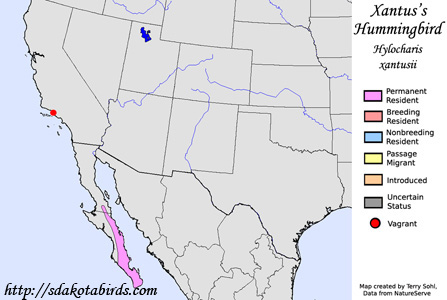| Length: 3.75 inches | Wingspan: 4.25 inches | Seasonality: Non-resident in South Dakota |
| ID Keys: Obvious white line behind eye, green upperparts, dark forehead and side of head | ||
 Xantus's
Hummingbird is a specialty of Baja California, with an extremely limited
home range. They are less likely to wander than many hummingbirds, yet
at least two records occur north of Mexico. One found in California
attempted to nest, although the nest failed to produce young. Another
individual was curiously found much farther north, in British Columbia.
The species is closely related to the
White-eared Hummingbird, which shares
many of the same plumage characteristics.
Xantus's
Hummingbird is a specialty of Baja California, with an extremely limited
home range. They are less likely to wander than many hummingbirds, yet
at least two records occur north of Mexico. One found in California
attempted to nest, although the nest failed to produce young. Another
individual was curiously found much farther north, in British Columbia.
The species is closely related to the
White-eared Hummingbird, which shares
many of the same plumage characteristics.
Habitat: Preferred habitat is dryland shrubs, thick shrubby forests, forest edges, and suburban areas. They evidently have adapted fairly well to a human presence within their range.
Diet: Typical diet of Hummingbirds, feeding heavily on nectar. Insects can comprise a large portion of the diet.
Behavior: Xantus's Hummingbirds are less aggressive than many hummingbird species, and are less likely to strongly defend feeding areas from other hummingbirds. .
Nesting: The nest is built with plant material interwoven with spider silk, with the outside of the nest covered in lichens. Nest placement is anywhere between 3 and 20 feet in height. As with many hummingbird species, the female alone builds the nest, incubates the eggs, and raises the young..
Song: Song a series of short rather non-musical notes.
Migration: Xantus's Hummingbirds are permanent residents in their normal range. However, there are some short-distance movements in conjunction with availability of flowering plants. The species is not known to wander widely, and very few records have occurred outside their normal range.
Interactive eBird map: Click here to access an interactive eBird map of Xantu's Hummingbird sightings
Feeders: Will attend hummingbird feeders
Similar Species: White-eared Hummingbird
Conservation Status: At present, Xantus's Hummingbird seem to have stable populations, and they are quite common in their normal range. They apparently adapt well to a human presence. However, their range in Baja California is extremely limited, and any major disturbance in their home range could thus impact a large portion of the Xantus's Hummingbird population.
Further Information: 1) Cornell's Neotropic Birds - Xantus's Hummingbird
2) WhatBird.com - Xantus's Hummingbird
Image Information: Colored pencil drawing by Terry Sohl
| Click below for a higher-resolution map |
 |
| South Dakota Status: Non-resident in South Dakota |
Additional Xantus's Hummingbird Images
Click for a higher-resolution version of these photos

